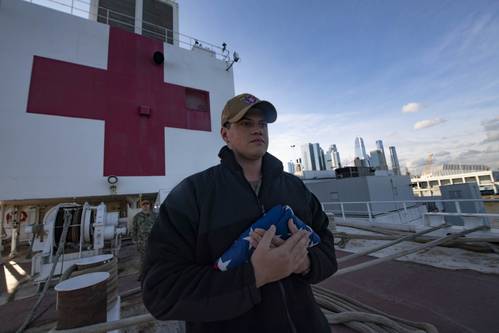Meterologists, Oceanographers Help Pave a Safe Path for USN Hospital Ships

U.S. Navy file photo of Aviation Boatswain's Mate 2nd Class Justin Cosgrove participating in morning colors aboard the hospital ship USNS Comfort (T-AH 20) while the ship is moored in New York City in support of the nation™s COVID-19 response efforts. (U.S. Navy photo by Mass Communication Specialist 2nd Class Sara Eshleman)
USNS Mercy (T-AH-19) arrived safely in Los Angeles last week and USNS Comfort (T-AH-20) arrived safely in New York on Monday. While the Navy’s hospital ships prepare to receive patients, Naval Oceanography’s team of meteorologists and oceanographers ensured these ships were safe from hazardous weather as they traveled to their destinations.
On March 20, Fleet Numerical Meteorology and Oceanography Center (FNMOC) rapidly configured two ship-following coupled ocean/atmosphere mesoscale prediction systems (COAMPS) for the USNS Mercy and Comfort. The center of these high-resolution weather models is the location of the hospital ship as they transited to Los Angeles and New York. Providing specific weather, wave and ocean predictions for their humanitarian efforts in response to COVID-19.
“Ship following COAMPS highlights Naval Oceanography’s culture of innovation. No other operational command in the world is able to provide an afloat unit a tailored and relocatable high-resolution model, and forecasts. Whenever, and wherever, the Navy operates, Naval Oceanography stands ready to deliver its advanced capabilities,” said Commander, Naval Meteorology and Oceanography Command Rear Adm. Okon.
The Pentagon activated USNS Mercy and USNS Comfort, staffed with active-duty and reservists medical personnel, to treat non-coronavirus patients along both coasts to relieve local hospitals amid surges in coronavirus patients.
Ship-following COAMPS is the Department of Defense’s only high-resolution, coupled atmosphere and ocean prediction system. FNMOC operates the ship following COAMPS to provide continuous coverage of atmospheric model data to ships at sea, not operating within normal or static forecast model locations.
“FNMOC is the foundation for Fleet safety. Every forecast starts with FNMOC environmental prediction products and services. We will continue to provide products to the Fleet to ensure patients are getting the care they need,” said FNMOC Commanding Officer Capt. Thomas Moneymaker.
FNMOC, located in Monterey, Calif., and Stennis, Miss., is the Navy’s premier numerical weather prediction center. FNMOC fulfills this role through a suite of global and regional meteorological and oceanographic models, extending from the top of the atmosphere to the sea floor.
Naval Oceanography has approximately 2,500 globally distributed military and civilian personnel, who collect, process and exploit environmental information to assist Fleet and Joint Commanders in all warfare areas to guarantee the U.S. Navy’s freedom of action in the physical battlespace from the depths of the ocean to the stars.
Source: Naval Meteorology and Oceanography Command Public Affairs Office

![Microplastic beads seen in the central tube of a copepod [their intestinal tract], as evidenced here, fluorescently labelled beads help with visualization and identification. © PML](https://images.marinetechnologynews.com/images/maritime/w100h100padcanvas/microplastic-beads-seen-166795.jpeg)











 December 2025
December 2025



